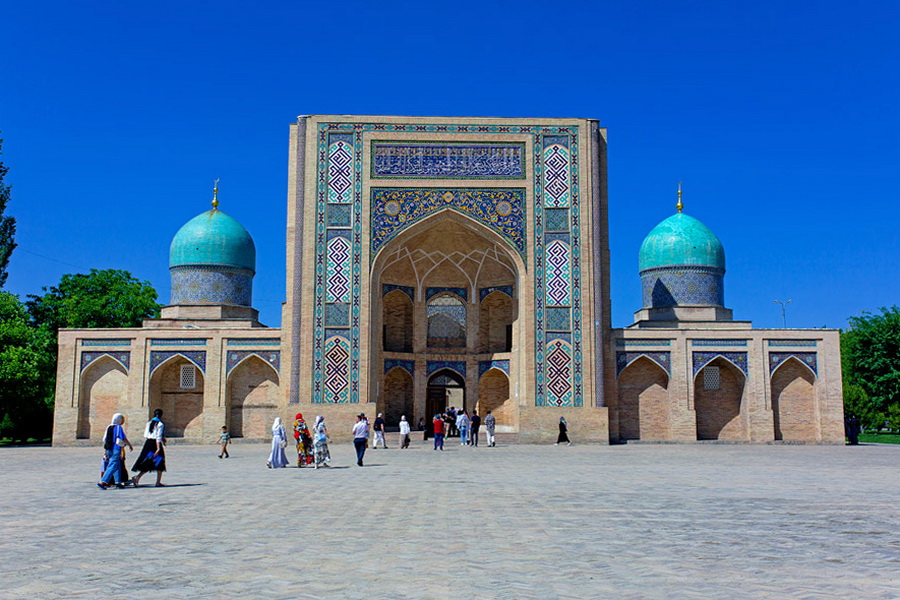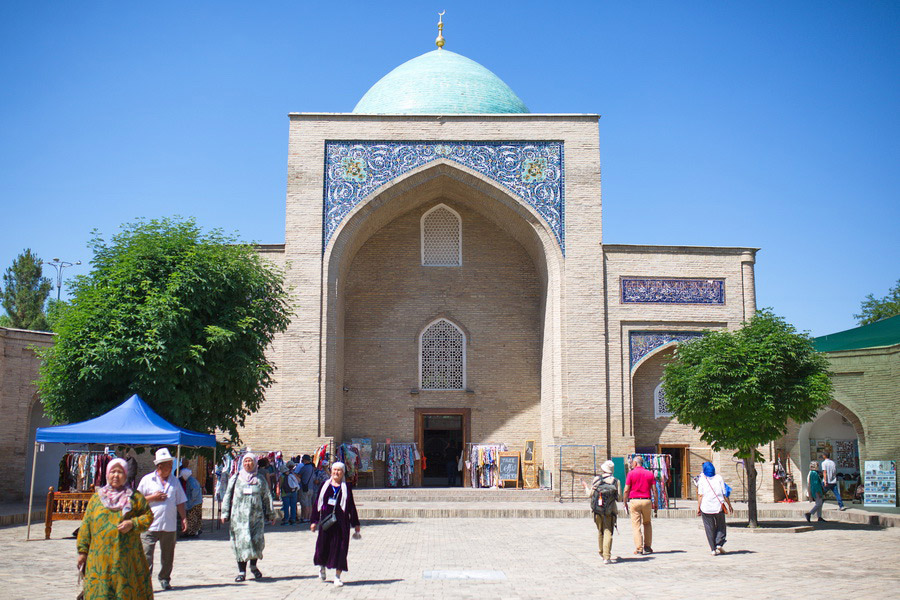Barak-khan Madrasah, Tashkent

Barakh-khan Madrasah: Depository of the Ottoman Koran
Barakh-khan Madrasah was built in the XVI century by Suyunidzh-khan, an Ulugbek’s grandson. It is a known fact that became a location of the Spiritual Administration of Muslims of Central Asia. It is also the place where the rich library of oriental manuscripts is found. A special premise of the Barakh-khan Madrasah library is used to keep the world-known Koran of Caliph Osman. It is the primary source of holy Islam book written in the mid-VII century. The ancient manuscript of very huge size, containing 353 parchment pages with the Koran original text, was kept for centuries in the caliphs’ treasury (consecutively in cities of Medina, Damascus and Bagdad). From Damascus, during Timur’s ministry, the Osman’s (Ottoman) Koran found its way to Uzbekistan, then (as late as in the ХIХ century) it was sent to Saint Petersburg where it was kept before the revolution. After it the Koran was brought to Central Asia via Ufa.
A legend has it that Caliph Osman was killed when he was reading this book, and from that time its pages made of deerskin keep his blood stains, since that the Osman’s Koran became a holy relic, kept at court of the subsequent caliphs first in Medina, then in Damascus and Bagdad. Different religious movements and sects, originated further inside the caliphate, at best, could deny selected parts in the scripture, claiming that they were distorted by careless scribes by mistake, or even with malicious intent of the caliph, who, for example, has not been honored up to date by the Shias, the supporters of inheritable power of Ali’s family. But they were not able to oppose other holy texts to the Ottoman Koran.

The historians do not know the exact destiny of all the manuscripts, after the occupation of Bagdad by the Mongolian khan Hulagu in 1258, who executed caliph al-Mustasim with his numerous servitors. But in the XV century the Koran with dried blood stains cropped up in Samarkand. First the Koran was kept at court of Mirzo Ulugbek, the Amir Timur’s grandson, who ordered to make a giant marble lectern for it in the Bibi-Khanum Mausoleum yard, then it found its way to the mosque of Sheikh Khodja Akhrar – a native of Tashkent.
When in 1868 Samarkand was occupied by the troops of the Russian Empire and annexed to the Turkestan Governorate General, the major-general Abramov, head of Zerafshan district, having known about this unique manuscript, withdrew it form the mosque by paying 100 gold rubles as a compensation to uncomforted caretakers. Then the Koran was sent to Tashkent to the governor general Konstantin von Kaufman, who a year later donated it to the Imperial Public Library in St-Petersburg.

In connection with any doubts in the authenticity of the Osman’s Koran, the Russian scientists who were investigating this book, came to the conclusion that it could be really written in the VII or VIII century in the territory of modern Iran.
In December 1917 the Territorial Muslim Congress of Petrograd national district applied to the People’s Commissariat for National Affairs with a request to give back the relic, holy for the Muslims, and five days later, they received a resolution “To issue immediately” signed by Lunacharsky, the People’s Commissioner of Education, after that the Ottoman Koran was handed over to the All-Russian Muslim Council, based in Ufa at that time. From there, in 1924 it was further handed over to Tashkent, then, brought back to Samarkand to the Khodja Akhrar Mosque. In 1941 the relic was sent to the History Museum of the Peoples of Uzbekistan for safe custody. Early in the 90-s, upon declaration of state sovereignty by Uzbekistan, Islam Karimov, the President of Uzbekistan handed the relic to the Mufti on Khast Imam Square.
It is still unknown how the Ottoman Koran found its way to Movarounnahr. According to the most prevailing version, the relic was found in 1393 during the invasion of the troops of Amir Timur who was building up a library of valuable manuscripts in his capital Samarkand. While according to a legend existed in the Sufi order Nakshbandia, headed by Sheikh Khodja Akhrar in the ХV century, it was obtained by a catchy dervish in troublous times upon Mongolian invasions. But among the Tashkent residents who considered Kaffal Shashi to be the first patron of the city there is a more popular folk legend according to which Khalif Osman’s Koran was brought from Bagdad by Kaffal Shashi. A unique handmade book was presented by Bagdad Khalif for Kaffal Shashi’s an outsanding poetic reply to the Byzantine Emperor.




